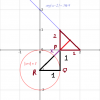the distance we need to find has 2 components, the purple and red distances.can somebody help me with this question
http://papers.xtremepapers.com/CIE/Cambridge International A and AS Level/Mathematics (9709)/9709_w13_qp_32.pdf
question 8b ???
If the purple distance is x then in triangle PQR
(1 + x)^2 = 1^ + 1^
x = sqrt2 - 1
In the brown triangle, the hypotenuse is sqrt2
the red distance is half of this
so the distance is (sqrt2 - 1) + sqrt2/2 = 1.12





